The R/V Thomas G. Thompson left Honolulu on November 5, 2011 heading toward the Western Pacific. This expedition journal was written by cruise participants and uploaded about once per weekday, depending on internet availability.
December 16, 2011: Last-half Science Operation Summary
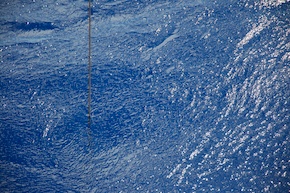
TowCam, it's down there (Credit: Will Koeppen)
During the second half of the cruise, we continued our quest for JQZ magnetic data. Upon conclusion of appeasing our Thor-like appetites on Thanksgiving, we all dutifully returned to our stations “teeming with greatness.” With the equipment and weather setbacks we experienced during the first half of the cruise, we had a long way to go to collect data over our entire survey line. Sentry was temporarily out of the water to work out its navigation issues, and we put our mid-depth magnetometer, TowCam, in the water and pressed onward, halting only to switch out the TowCam’s battery. After a couple of days lumbering along at 1.5 knots, we brought TowCam up from the depths so it could take a break.
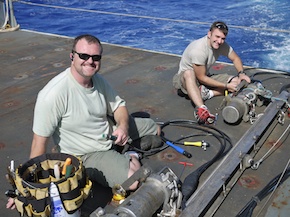
Cleaning air guns (Credit: Adrienne Oakley)
Sentry was deployed for a quick test of its retooled navigation code; however, the test ended when Sentry dove beyond its designated depth, failing to release its dive weights at ~1500 meters. Sentry continued to descend until it reached ~2000 meters, where the weights were finally released, and the AUV was given the command to surface so the team could identify what caused the slight malfunction. While the Sentry team put in long hours on our little yellow friend, the seismic team was given the go-ahead to deploy the streamer, air-guns, and sonobuoys to conduct seismic surveys for the next four days, covering the entire survey line. After the relatively smooth and routine collection of seismic data, we began recovering the equipment. On its way in, our seismic guru, Lee Ellet, noticed something about the streamer, it now had lacerations in its fleshy covering and was leaking silicone gel. Because they were evenly spaced, it meant the cuts weren’t caused by something random, he told us that a shark had made a faint-hearted attempt at turning our streamer into a meal. Lee patched the streamer and we finished recovering the seismic gear for the last time. With about two weeks of science operations left, we put Maggie in the water and returned to the Northeast.
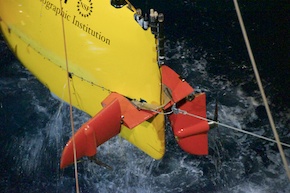
Hanging by a string, literally (Credit: Will Koeppen)
Sentry was deployed for another test dive and everything looked good, building our hopes that this would be our break. The test ran smoothly until it was time for Sentry’s recovery. The AUV was located rather easily and brought in close to the ship so the team could capture it with hooks and lines. Steering the vehicle became difficult in the heightened and confused sea state, and it got very close to the ship. Our hearts sank as we watched the AUV dip under the ship near the starboard side Z-drive propeller of the Thompson. Luckily, the propeller was turned off, sparing Sentry’s body, frame, and vitals major damage, but when we saw it again on the surface, two of its starboard-side wings were hanging limply from the vehicle. In retrospect, we learned that the bolts securing Sentry’s starboard side wings sheared off — this was very good news, because they acted as they were designed to, by imitating break-away mirrors to prevent major damage to the wings and vehicle. After a long battle during which Sentry had no steering capabilities the team finally captured it and got it back on board. Then they bedded down for a few hours to prepare for their next couple of long days.
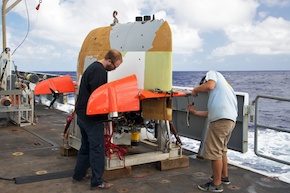
Repairs in progress (Credit: Will Koeppen)
While the team repaired Sentry, we deployed the surface Maggie, which ran for about a day and a half. By the time we reached our waypoint with surface Maggie, Sentry was chomping at the bit to get back in the water. It was scheduled for a full-length dive to 6000 meters. Again, everything started smoothly, as we deployed Sentry and TowCam, but some hours later Sentry surfaced after completing only half of its planned dive. On the positive side, being able to see and positively identify Sentry’s early exit was well ahead of previous dives, when it was gone from our monitors entirely. A thorough investigation by the Sentry team led them to believe that somehow, somewhere, an acoustic signal was sent to Sentry – the same signal that the Sentry team normally uses to abort a mission. The mystery of the signal source still eludes us, leading some to speculate: “Could it be aliens?” “Maybe a nearby spy sub?” Although Sentry came up early, the dive proved that it was responsive to commands. With Sentry back on deck, TowCam (a.k.a. TowMag) was re-deployed with a second battery in order for us to brave our version of “Groundhog Day.” Others refer to this nearly five-day long event as “TowMagathon,” in which we set the blazing pace of 1.5 knots down our survey line.
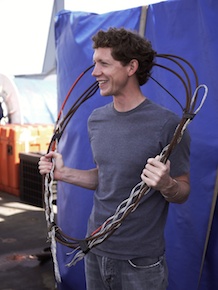
Battery estimator extraordinaire
(Credit: Adrienne Oakley)
Without much to do in terms of deployments and retrievals, we passed the time by placing some friendly bets on when TowCam’s newly rigged dual-battery system would die, causing us to halt and change out batteries. A single battery had a rated life of 38 hours, but in a previous run the battery had died after ~24 hours of use. With two batteries, guesses ranged from pessimistic (50 hours) to what some of us considered blind faith (71 hours). Unfortunately for most of us in the guessing pool, the batteries lasted beyond their full, expected life of 76 hours! After a surprising 80hrs 35min of being below 4000 meters, the batteries were finally too low on juice to send any data. Will, our resident photography and web entrepreneur, was declared the winner of the yet unknown prize. The next day we had a ceremony in which Maurice presented Will with his certificate of achievement (“Most Optimistic Estimate of TowCam Battery Life, bestowed by the Society of TowCam Engineers and Wranglers”), and called down Andy Billings to bestow upon Will his trophy, a lei made of used TowCam cable that made it down to 3500 meters.
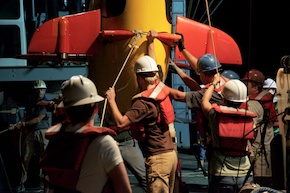
Without a hitch (Credit: Will Koeppen)
For the final stretch of survey line, we continued collecting magnetic data, alternating between surface Maggie and TowCam. Sentry went back in the water for one last time during this cruise, and it performed a beautiful symphony for us that lasted the entire 34.5-hour dive! From start to finish, the dive went without any hiccups and Sentry was finally satisfied to be strapped into its cradle to head back home. With Sentry’s missions all wrapped-up and the seismic team already taking apart the gun set-ups and seismic streamer, we gave TowCam its final run in the water. Many of us came out on deck to watch the last TowCam recovery, but the task was eerily quiet, quick, and done. There were very few cheers, and I think that each of us on deck realized at that moment that what we’ve experienced out here was truly coming to an end.
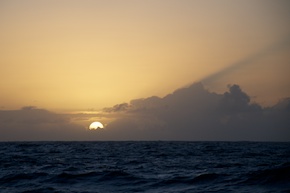
The last one, for us (Credit: Will Koeppen)
We are still collecting data with the surface Maggie, but the TowCam sled has now been reduced to nothing more than an empty frame. The seismic gear is completely stowed, and many computers, displays, and other systems have been taken offline in the computer lab. Most of today was spent cleaning the lab, digitizing hand-plotted maps and notes, and exchanging pictures. Although our shifts are being rotated out as we steam westward near the Mariana Trench, we vigilant watchstanders are still charged with the duty of serving at our post until properly relieved at our final waypoint tomorrow morning: Guam. ♦
